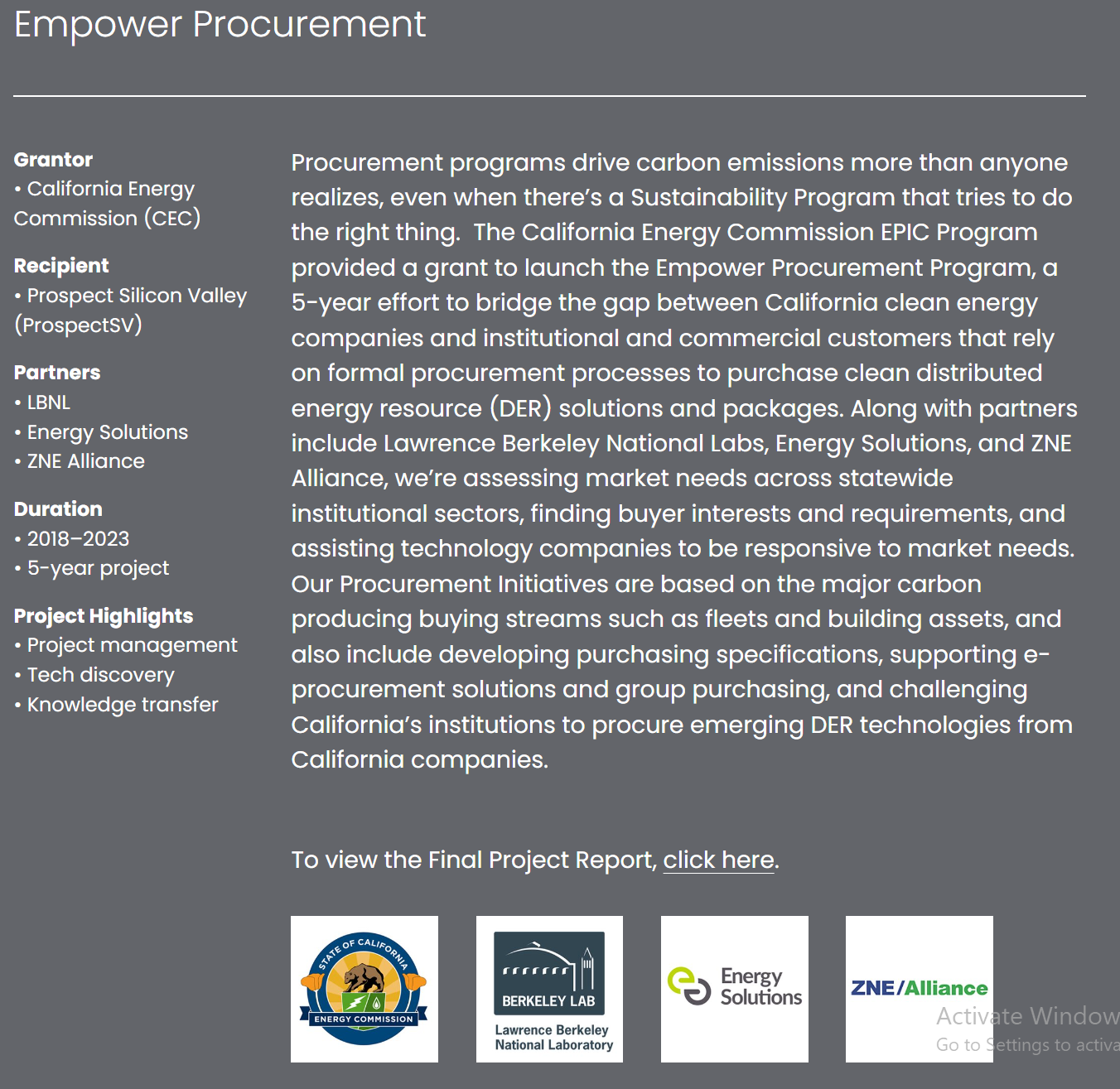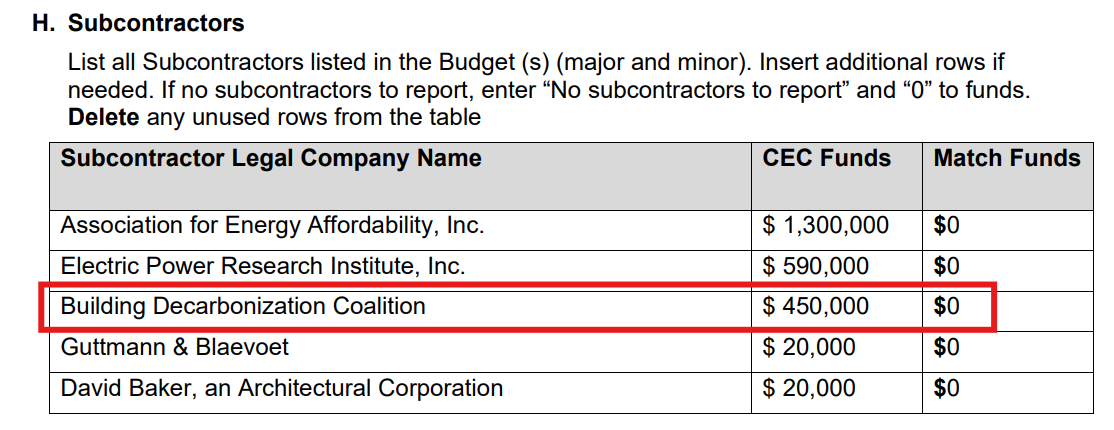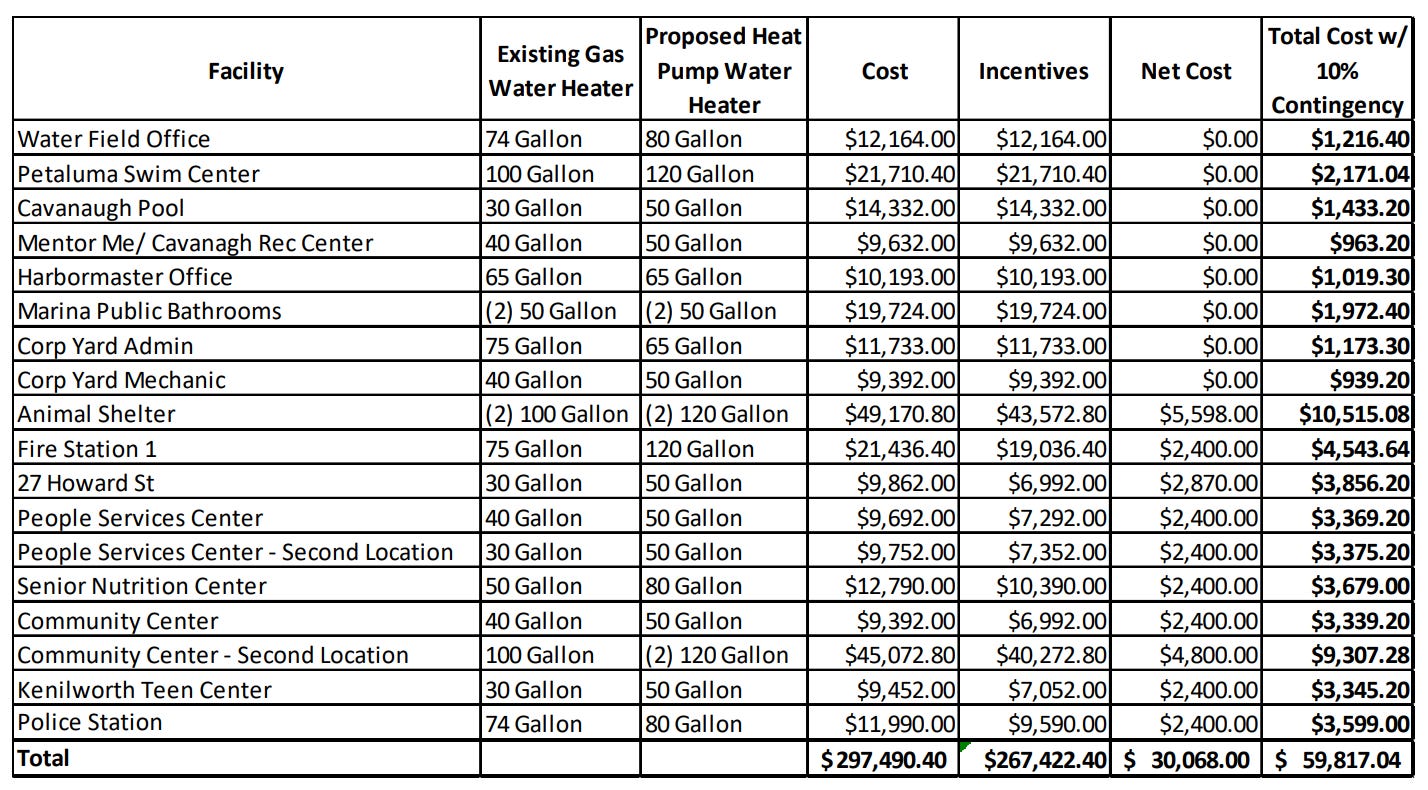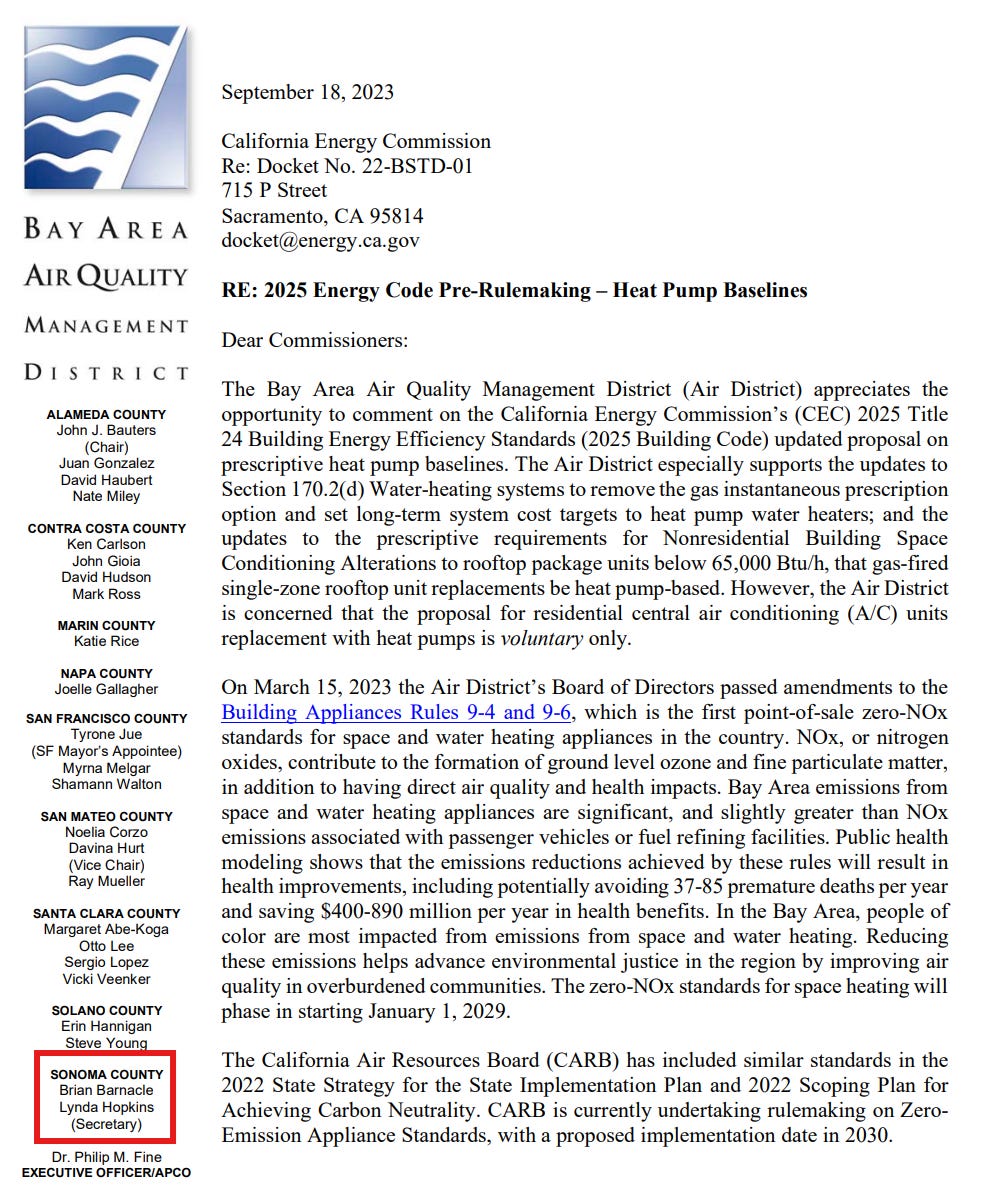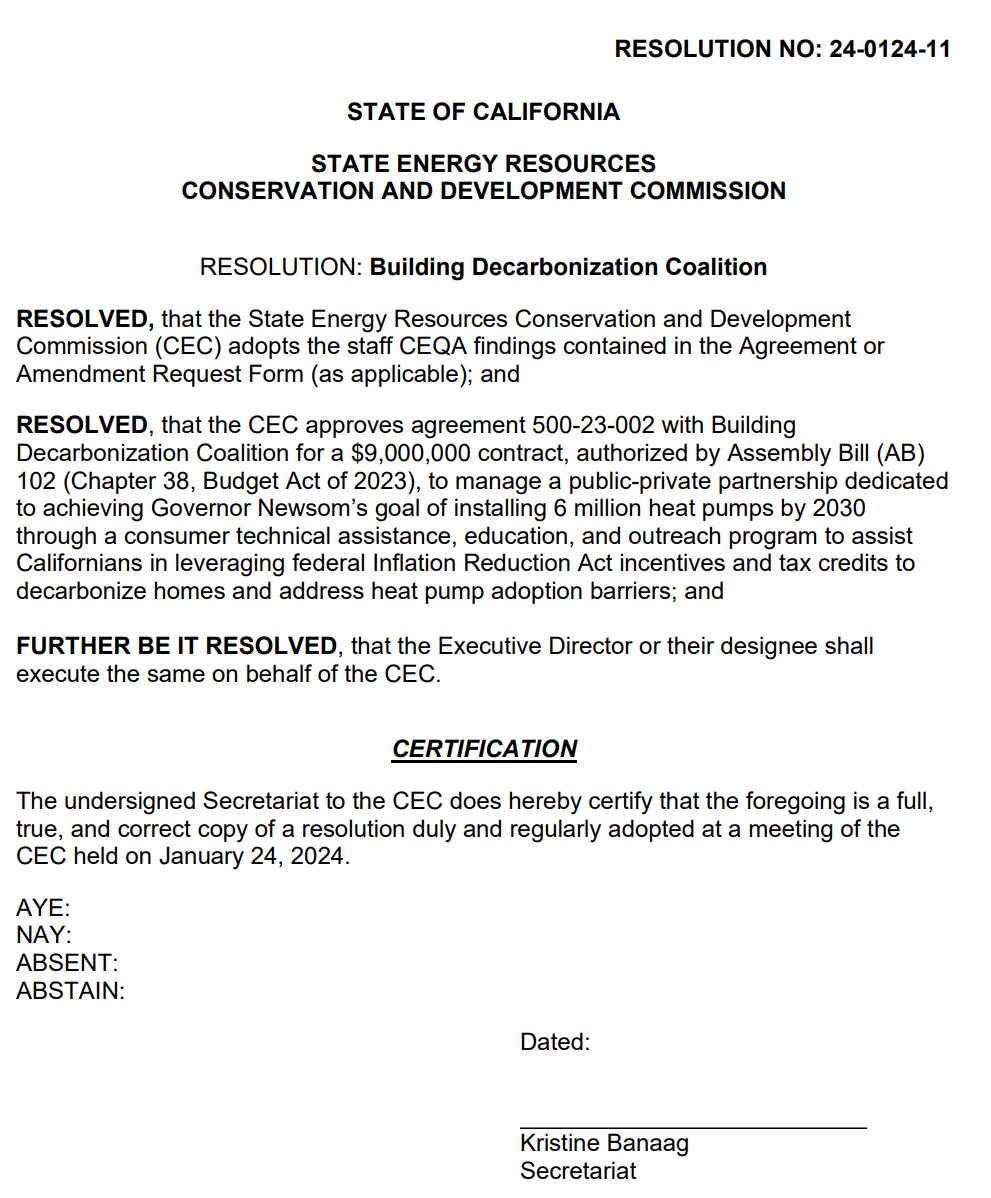Barnacle Failed to Publicly Disclose Income as Senior Manager, Energy Solutions While Claiming He is Fully Transparent
Petaluma Councilman Brian Barnacle has continually voted through local agencies to mandate all-electrification while being paid to push incentives
Every elected official and public employee who makes or influences governmental decisions is required to submit a Statement of Economic Interest, also known as the Form 700. The Form 700 provides transparency and ensures accountability in two ways:
It provides necessary information to the public about an official’s personal financial interests to ensure that officials are making decisions in the best interest of the public and not enhancing their personal finances.
It serves as a reminder to the public official of potential conflicts of interest so the official can abstain from making or participating in governmental decisions that are deemed conflicts of interest.
Per the Fair Political Practices Commission’s (FPPC) Questions and Answers website:
On a candidate statement, disclose all reportable investments, interests in real property, and business positions held on the date you file your declaration of candidacy. You must also disclose income (including loans, gifts and travel payments) received during the 12 months prior to the date you file your declaration of candidacy.
Petaluma Councilman Brian Barnacle is seeking re-election in the November 5, 2024 General Election. When he initially ran for Council in 2020, his Form 700 (statement of economic interest) was received by the City of Petaluma’s Clerk on August 6, 2020.
He indicated that his only source of reportable financial interest for the time period was Outthink, LLC, a consulting firm. His main clients were Prospect Silicon Valley & Building Decarbonization Coalition.
As of June 26, 2019, Mr. Barnacle was indicated as a speaker for Catalyzing Decarbonization and Market Transportation through Procurement on behalf of Energy Solutions.
His current campaign website indicates that he was the Senior Manager of Energy Solutions. However, he did not appear to itemize this source of income within his 2020 candidate SEI.
The California Public Utilities Commission Service List updated December 9, 2021 indicated that Mr. Barnacle was actively employed with Energy Solutions.
Energy Solutions is focused on creating large-scale environmental impacts by providing cost effective, market-based carbon, energy, and water management solutions.
Setting the Stage for Future Contracts Through Local Agencies
On December 12, 2018, the Silicon Valley Clean Energy Authority was presented with a draft Memorandum of Understanding (MOU) between Prospect Silicon Valley, Mr. Barnacle’s Outthink client and Silicon Valley Clean Energy. The MOU stated the following:
This MOU shall remain in effect for three (3) years from the date of final signature and is renewable thereafter by written, mutual agreement of the Parties.
ProspectSV can add value to these efforts in the following ways.
A) Identify and define industry needs and interests to inform SVCE program development
Leverage ProspectSV’s ecosystem to validate assumptions and broaden insights into commercial and industrial (C&I) sustainability requirements in the mobility, energy and built environment
Conduct small Industry focus groups/interviews, where applicable, to further define how best to engage with the community in the deployment of SVCE solutions
B) Give visibility to SVCE and its programs in the context of ProspectSV’s ACES Bay Area Network Working Group, Innovation and Impact Symposium and other ecosystem events
Provide a platform for SVCE to promote its initiatives
Invite Industry participants with interest in SVCE offerings to engage in defining levels of collaboration that will support SVCE goals and objectives
Participate in joint media events to highlight SVCE achievements
C) Seek out and engage potential collaborators to help define, plan and deploy SVCE programs
Seek potential collaborators in ProspectSV’s routine Industry contacts
Share information and promote the ProspectSV-SVCE partnership
Refer prospective collaborators with SVCE
D) Provide direct support to SVCE in the creation and deployment of sustainability programs to effect market transformation
Design and execute novel program mechanisms to activate the private sector, such as a “prize”
Engage with SVCE to design a community-wide EV readiness and infrastructure plan
Provide resources extending SVCE staff capabilities to validate emerging technologies and deploy and manage sustainability initiatives
Provide support in data analytics to measure the impact of these programs on SVCE goals and objectives
Conduct awareness and education programs as requested
Pursue relevant grant funding opportunities to defray the costs associated with SVCE programs
On December 20, 2023, the California Energy Commission (CEC) published the California Opportunities for Procurement to Accelerate Clean Energy (Cal-Op ACE) Report.
The project duration was 2018-2023, the grantor was the (CEC), recipient ProspectSV and partners, LBNL, Energy Solutions and ZNE Alliance for a 5-year project.
The Empower Procurement effort declared a goal of identifying pathways to achieve annual energy savings of $322 million and annual greenhouse gas emissions reduction of 780,000 metric tons of CO2e (MTCO2e). The observations and recommendations of the project initiatives identified pathways to avoid emissions of more than 1 million MTCO2e across the local government, schools, and higher education sectors.
The Technical Advisory Committee itemized within the report included Petaluma Climate Action Commissioner Panama Bartholomy, Founder and Executive Director, Building Decarbonization Coalition.
The report abstract stated:
California Opportunities Procurement Program Accelerate Clean Energy is a California Energy Commission-funded program designed to accelerate the deployment of best-in-class distributed energy resources (DERs) at the speed and scale required to meet the state's decarbonization goals. Empower Procurement, the program’s market-facing name, bridged the gap between DER "sellers" and California-based "buyer" organizations by improving institutional procurement processes and outcomes.
Led by Prospect Silicon Valley, the primary project partners included Lawrence Berkeley National Laboratory, Energy Solutions, and ZNE Alliance. The four-year, $4 million project created an integrated set of DER Procurement Initiatives: DER Products and Services, Vehicle Fleet Electrification, Building Decarbonization, DER Consulting Practices, and Contract Language. The team engaged client partners from local governments, higher education, and K-12 schools to identify specific measures that addressed procurement barriers, produced measurable energy cost savings and reductions in carbon emissions, and scaled across similar institutions. In addition, a Working Group of expert stakeholders identified measurable and scalable improvements in the design and deployment of Electronic Procurement Systems to improve and standardize DER procurement.
The project team shared insights from these initiatives across public sector institutions by hosting webinars and workshops throughout the grant, and it provided technical assistance for the more complex sectors undertaking fleet electrification and building decarbonization.
The Empower Procurement effort declared a goal of identifying pathways to achieve annual energy savings of $322 million and annual greenhouse gas emissions reduction of 780,000 metric tons of CO2e (MTCO2e). The observations and recommendations of the project initiatives identified pathways to avoid emissions of more than 1 million MTCO2e across the local government, schools, and higher education sectors.
On January 5, 2022, BDC issued the following press release:
“The Building Decarbonization Coalition is very hopeful about the critically important benchmarks the Governor outlined in her address. We applaud the aggressive commitments in two million all-electric, decarbonized homes by 2030, new investments in decarbonized affordable housing and a first in the nation program to decarbonize and electrify hundreds of schools statewide. These commitments are vital first steps in our road to creating thousands of high quality jobs decarbonizing all public, commercial, residential buildings in the State of New York. We look forward to working with the Governor to secure concrete investments from the State to ensure success.”
New program features incentives, live advisors, vetted contractors, ambassadors and more
Media:
Nia Evans
Media Senior Account Executive, Antenna
bdc@antennagroup.com
415-316-7965
December 16, 2021 10:00 AM Eastern Standard Time–(BUSINESS WIRE)–
Today, the Building Decarbonization Coalition (BDC) and its partners launched the “Switch Is On“ campaign to help Californians switch from gas-powered to all-electric appliances. This campaign is the first of its kind in California, and hopes to serve as a template for similar programs across the nation. An all-electric home reduces health risks, contributes to a more resilient energy system, supports the state’s decarbonization goals, and in many cases can save money for homeowners.
“The only way California — and the world at large — will meet its climate goals will be to electrify our homes and businesses,” said Panama Bartholomy, Executive Director of the Building Decarbonization Coalition. “Modern electric appliances are cleaner, more efficient, and simply better than gas-powered alternatives. By sharing knowledge with everyday Americans and guiding them through the process of electrifying their homes, this campaign will catalyze the transformation to a cleaner, safer energy future.”
In addition to promoting regional and statewide incentives for electrification, the “Switch Is On“ campaign will educate, inspire, and support Californians who want to join the movement to electrify their homes. People can visit Switchison.org to speak one-on-one with home electrification advisors, find vetted contractors, get information on incentives and rebates, and find additional resources about home electrification.
The campaign’s statewide launch comes after a 2020 pilot program promoting electrification in the Bay Area and two years of market research. Through creative media, a grassroots ambassador program and a robust website, the campaign educates people about the value of swapping out gas-powered water heaters, dryers, cooktops and furnaces for electric alternatives, and provides information on a variety of incentives to support the switch. The campaign also educates homeowners about clean energy initiatives such as energy efficiency and weatherization, and related technologies like home solar and battery storage.
“The need to electrify everything is one of the most important climate narratives of our lifetime, and not enough people are talking about it,” said Saul Griffith, Co-founder of Rewiring America and author of Electrify! “The Switch Is On campaign is a needed, timely and critical effort that will educate Californians about how they can electrify their lives with technology that already exists, and save money on their bills without sacrificing their lifestyles. It turns out that we can all do our part to address climate change by improving our personal infrastructure. We are excited to help the Building Decarbonization Coalition build this movement, and to promote the campaign’s success.”
“I couldn’t be happier living in a decarbonized home,” said Ann Edminster of Petaluma. “The Switch Is On campaign will help Californians understand the benefits of swapping out their gas appliances for electric ones that are better for their health, convenience, and the environment. I have no hesitation recommending electrification to all my friends, neighbors, and family.”
The campaign is supported by TECH Clean California, a statewide initiative under the auspices of the California Public Utilities Commission (CPUC), designed to accelerate the adoption of clean space and water heating technology by providing incentives and training to support contractors electrifying homes. Additional campaign partners include Bay Area Air Quality Management District, the Bay Area Regional Energy Network (BayREN), East Bay Community Energy, Peninsula Clean Energy, Pacific Gas & Electric (PG&E), Southern California Edison (SCE), City of Santa Monica, City of San Jose, Silicon Valley Clean Energy, Central Coast Community Energy, Marin Clean Energy, Los Angeles Department of Water and Power (LADWP), and the Tri-Country Regional Energy Network (3C-REN).
The Switch Is On campaign can be found at www.switchison.org. All Californians — including homeowners, renters and contractors — are encouraged to go to the website to learn more and get support in electrifying their homes. Those who have already begun their electrification journey can join the campaign’s ambassador program here.
About The Building Decarbonization Coalition
Launched in 2018, the Building Decarbonization Coalition (BDC) forges public-private partnerships among government authorities, utilities, manufacturers, builders and other vital sector stakeholders. These diverse and dynamic partnerships drive the development of clean energy powered, zero-emission homes, commercial Buildings and communities.
On January 25, 2023, the California Energy Commission’s solicitation department sought proposals for a third-party program administrator to design and implement an incentive program and provide technical assistance to potential and current program applicants for transitioning to California Electric Homes. The third-party administrator selected to receive the grant funds will distribute incentives for all-electric buildings and energy storage systems in new residential market-rate construction in California. (General Fund Funding).
The Proposed resolution selected TRC Engineers, Inc. to help design and implement a residential all-electric and energy storage construction incentive program in California and provide technical assistance. Funding for this agreement is up to $68,124,971, including up to $58,125,000 to be distributed as incentives and up to $9,999,971 for administrative costs.
As the Director of Strategy & Development, Building Decarbonization Coalition, Petaluma Councilman Brian Barnacle received a $450k grant with $0 in matching funds for his organization as a TRC Engineers subcontractor.
The program began January 25, 2023 with an end date of January 24, 2029.
Mr. Barnacle ‘s term on the District Board for the Bay Area Air Quality Management District is 02/09/23 - 02/09/25. He is also a Member of the District’s Stationary Source and Climate Impacts Committee.
On March 15, 2023, the Bay Area Air Quality Management District Board of Directors voted in favor of the following:
Chair Bauters made a motion, seconded by Director Lopez, to adopt proposed amendments to Regulation 9, Rule 4: Inorganic Gaseous Pollutants, Rule 4: Nitrogen Oxides from Fan Type Central Furnaces (Rule 9- 4) and Rule 6: Nitrogen Oxides Emissions from Natural Gas-Fired Boilers and Water Heaters (Rule 9-6) and Certification of an Environmental Impact Report for the proposed amendments to Rule 9-4 and Rule 9- 6 pursuant to the California Environmental Quality Act; and the motion carried by the following vote of the Board…
Director Barnacle did not recuse himself from this vote.
The Air District Board of Directors adopted amendments to Regulation 9, Rules 4 and 6, to eliminate emissions of nitrogen oxides, or NOx, from residential and commercial natural gas furnaces and water heaters in the Bay Area by requiring new appliances to be zero-NOx.
Mr. Barnacle’s vote presents a conflict of interest as he is paid through the BDC to lead development and strategies to support all-electrification while receiving grant funds to promote incentives.
On Wednesday, May 17, 2023, the Bay Area Air Quality Management District held a Board of Directors Special Budget Hearing.
Mr. Barnacle did not abstain from the discussions to approve incentives for the fiscal year.
The Air District funded the creation of the Building Decarbonization Coalition’s Clean Building Compass, a comprehensive building decarbonization policy clearinghouse for local governments seeking guidance on a spectrum of different policy pathways.
On December 18. 2023, Petaluma Councilman Brian Barnacle voted in favor of Adopted Resolution No. 2023-186 N.C.S. Authorizing the City Manager to Enter into an Agreement with Willdan to Install Heat Pump Water Heaters at City Facilities. The Resolution stated the following:
“WHEREAS, the City of Petaluma has set a goal for the entire community to be carbon neutral by 2030; and
WHEREAS, has entered into an agreement with Syserco to examine energy efficiency, conservation, and fuel switching measures; and
WHEREAS, Willdan, PG&E’s contractor selected through a competitive process, contacted staff regarding a program focused on government facility water heater replacement projects; and
WHEREAS, the Government and K-12 program (GK12) serves Federal facilities, local-government facilities and K-12 Schools across the PG&E service territory; and
WHEREAS, this program contributes to PG&E’s efforts to achieve energy efficiency (EE) and greenhouse gas reduction goals set forth by the State of California; and
WHEREAS, the GK12 program provides technical and financial assistance to local government for comprehensive retrofits that save energy, reduce customer demand for electricity, and increase overall operational efficiency; and
WHEREAS, replacing existing gas water heaters with heat pump water heaters are eligible projects for this funding source; and…
WHEREAS, the City’s purchasing rules require the City to formally bid any purchase over the Charter threshold, currently around $31,000; and
WHEREAS, the common law recognizes a bidding exception for circumstances where competitive bidding of public contracts otherwise required by statute may be excused, including circumstances where the contract is such that competitive proposals would be unavailing or would not produce an advantage, and the advertisement for competitive bid would thus be undesirable, impractical, or impossible (Graydon v. Pasadena Redevelopment, Agency (1980) 104 CA3d 631); and
WHEREAS, due to the unique circumstances related to the participating in PG&E’s GK-12 program and the requirement to use PG&E’s selected contractor, Willdan, this agreement with Willdan, and any associated equipment purchases, is eligible for a sole source purchase…”
Staff provided the following discussion as included in the report at the Dec. 18, 2023 Council Meeting:
“Willdan visited all City facilities and identified twenty natural gas water heaters that could be replaced with twenty-one heat pump water heaters. Facilities include 27 Howard St., Cavanaugh Pool and Recreation Center (two units), Community Center (two units), Corporation Yard (three units), Fire Station 1, Kenilworth Teen Center, Marina (three units), Petaluma People Services Center (two units), Police Department, Senior Center, Swim Center, and Water Field Office.
Willdan estimates the total project cost to replace the twenty identified water heaters to be $327,206.44, including a 10% contingency. Incentives from PG&E would total $236,422.40 and incentive from SCP would be $31,000 for a total of $267,422.40. Willdan has identified other potential funding sources (including the California Self Generation Incentive Program) that may close all funding gaps, but in the event those programs are not available or advantageous, staff recommends allocating $59,817.04 toward this project in the event of a worst-case scenario. Costs include the equipment, labor at prevailing wages, any necessary electrical wiring runs, panel upgrades, vents, and custom bases for the unit.”
As of May 30, 2024, BDC issued the following press release:
“Sacramento, CA – Yesterday, the California Heat Pump Partnership (CAHPP) officially launched with its first convening to bring together state agencies, manufacturers representing more than 90% of the U.S. consumer heat pump market, utilities, and other market actors to help achieve the state’s goal to install six million electric heat pumps by 2030. Launched with a shared vision to catalyze a sustainable, decarbonized future, the public-private partnership will drive forward a clean energy economy and advance California’s climate objectives by propelling widespread heat pump adoption through cross-sector collaboration and strategic partnerships.
“California knows how to scale clean energy. We’ve done this with electric vehicles, solar, wind, and battery storage—and now it’s time to take the benefits of heat pump technology mainstream,” said California Energy Commission Chair David Hochschild. “Heat pumps provide Californians a way to both cool and heat their homes with no pollution. The California Heat Pump Partnership will help government and industry leaders do the barrier-busting necessary to ensure heat pumps are accessible to all Californians.”
“The Building Decarbonization Coalition is uniquely positioned to manage the partnership, and bring together state and industry leaders to rapidly grow the heat pump market in California,” said Terra Weeks, Director for the CAHPP. “Scaling this technology will usher California into a new era of clean electric heating and cooling, and propel the state toward a carbon neutral future.”
The CAHPP will develop a blueprint outlining how to address technical, market, and policy barriers for achieving the state’s heat pump targets. The partnership will also deploy a statewide consumer marketing campaign through The Switch Is On, an initiative launched by the Building Decarbonization Coalition, to educate, inspire, and make switching to electric appliances easier for communities, contractors, and all those who live and work in buildings.
“As California moves toward a carbon-neutral future, it’s crucial to foster close coordination between state and market leaders to achieve our building decarbonization goals,” said California Public Utilities Commission President Alice Reynolds. “The Heat Pump Partnership is a vital step in supporting California’s transition to clean electric heating and cooling. By aligning key stakeholders in the clean energy transition, we can minimize costs and maximize benefits for all Californians, driving us towards a more sustainable future.”
“California has advanced climate and air quality solutions through innovation and collaboration between government, communities, and industry to ensure equitable outcomes,” said California Air Resources Board Chair Liane Randolph. “The heat pump partnership is the latest example of how state agencies and other climate leaders are working together to face the growing threat of extreme heat and the need to decarbonize with action, urgency, and a commitment to addressing the needs of vulnerable Californians.”
California currently has about 1.5 million heat pumps deployed and is on pace to install less than 200,000 heat pumps a year. To close the gap of 4.5 million heat pumps by 2030, heat pump adoption will need to nearly quadruple with about 750,000 units installed annually. Large-scale coordination efforts like the CAHPP are crucial to align major players in the clean energy transition and support California’s climate goals. Scaling heat pump adoption in the world’s fifth largest economy will also act as a global market signal, with the potential of transforming the world’s green economy.
“As a global leader in intelligent climate and energy solutions, Carrier is committed to supporting the installation of six million heat pumps in California’s buildings by 2030,” said Kyle Gilley, Vice President of Government Relations at Carrier. “Electrification continues to be a solution for reducing greenhouse gas emissions and we are proud to be contributing to a greener tomorrow with our high quality, energy efficient, sustainable heat pump systems.”
“The California Heat Pump Partnership represents the public-private collaboration that we need to accelerate the adoption of advanced heat pumps, such as those that utilize inverter technology,” said David Calabrese, Senior Vice President of Government Affairs at Daikin. “As a global leader in providing heat pumps, we are committed to working with the California government, its utilities, the environmental community, and our industry to help meet the state’s six million heat pump target and ensure that this technology is accessible to all Californians.”
The partnership also builds on an agreement made last year by ten of the world’s largest manufacturers, distributors, and suppliers of heating and cooling equipment for buildings to rapidly scale the heat pump market. That agreement outlined commitments to help create manufacturing capacity, enhance efficiency, and incorporate load flexibility to decarbonize California’s buildings.
“As a leading manufacturer serving the California market with efficient electric space, water heating, and pool heat pumps, Rheem is committed to supporting the state’s goals to install six million electric heat pumps by 2030,” said Chris Day, Vice President, Global Product Strategy, Marketing and Training at Rheem. “The objective of the Partnership and Market Advisory Board is to scale heat pump installations through collaboration with the entire supply chain and channel partners. I am excited about the ability of the Partnership to focus the state on the most important policy and market levers to drive heat pump adoption and Rheem’s role in enabling wide-scale building decarbonization.”
“Our company is pleased to participate and contribute its more than twenty years of heat pump water heating expertise to the California Heat Pump Partnership as the state of California embarks on its ambitious goal of installing six million new heat pumps and heat pump water heaters by 2030,” said Joshua C. Greene, Corporate Vice President for Government, Regulatory, and Industry Affairs at A. O. Smith. “Through the leadership of Governor Newsom and the California Energy Commission, these combined efforts will help emphasize the co-benefits that heat pump technology offers—decarbonizing the built environment to help mitigate the impacts of climate change and lowering utility costs that will save consumers money.”
“Decarbonizing the built environment is within reach and comes with improved air quality, lower energy use, and more personal comfort,” said Dana Fischer, Senior Director of Regulatory Strategy at Mitsubishi Electric. “Mitsubishi Electric Trane HVAC U.S. is ready to do our part in achieving ambitious heat pump goals in California. Together we can make changes for the better.”
The California Heat Pump Partnership members include:
Heat pump manufacturers, including A. O. Smith, Bradford White, Carrier, Daikin, Fujitsu General America, Inc., Johnson Controls, Lennox, LG, Mitsubishi Electric, Rheem, and Trane Technologies
Distributor: Ferguson
Electricity providers, including Pacific Gas and Electric, Edison International, Sacramento Municipal Utility District, and Ava Community Energy
Policymakers representing the California Energy Commission, California Air Resources Board, California Public Utilities Commission, and the Office of Governor Gavin Newsom
Innovation leader: Los Angeles Cleantech Incubator
###
The California Heat Pump Partnership (CAHPP) is a groundbreaking alliance that brings together leaders in the public and private sectors to rapidly scale California’s heat pump market.”
According to a recent interactive forum held by BayREN:
“California has an ambitious goal of installing 6 million heat pumps by 2030; homeowners can draw on millions of dollars in incentives to switch to heat pumps; and the Bay Area Air Quality Management District (BAAQMD) has adopted rules that will require zero-NOx appliances such as heat pumps. As a result, building departments will see increasing numbers of permit applications for heat pump projects.”
On September 18, 2023, the BAAQMD District sent the following letter to the California Energy Commission. An excerpt stated the following:
“On March 15, 2023 the Air District’s Board of Directors passed amendments to the Building Appliances Rules 9-4 and 9-6, which is the first point-of-sale zero-NOx standards for space and water heating appliances in the country. NOx, or nitrogen oxides, contribute to the formation of ground level ozone and fine particulate matter, in addition to having direct air quality and health impacts. Bay Area emissions from space and water heating appliances are significant, and slightly greater than NOx emissions associated with passenger vehicles or fuel refining facilities. Public health modeling shows that the emissions reductions achieved by these rules will result in health improvements, including potentially avoiding 37-85 premature deaths per year and saving $400-890 million per year in health benefits. In the Bay Area, people of color are most impacted from emissions from space and water heating. Reducing these emissions helps advance environmental justice in the region by improving air quality in overburdened communities. The zero-NOx standards for space heating will phase in starting January 1, 2029…
The Air District strongly encourages the California Energy Commission (CEC) to consider requirements for the replacement of residential central A/C units with heat pumps in the development of the 2025 Building Code Chapter 6. Heat pumps are zero-emission appliances that are consistent with the Air District's zero-NOx and CARB’s proposed zero-emission appliance standards, support the goals of the CEC to increase building energy efficiency cost-effectively, and contribute to the state’s GHG reduction goals. Since heat pumps provide both cooling and heating for space conditioning, the assumption of zero-NOx and zero-emission heating appliance installations upon burn-out of gas furnaces post-2029 in the Bay Area and 2030 statewide should be included in the analysis of the broader costs of the CEC’s decision-making. Residents who install a non-heat pump A/C unit post-2025 and then are required to purchase a zero-NOx or zero-emission heating appliance—most likely a heat pump—upon gas furnace burnout while the A/C unit is still relatively new would incur an avoidable and unnecessary cost burden.
The Air District recommends that the CEC requires the replacement of residential central A/C units with heat pumps in the development of the 2025 Building Code Chapter 6. This will advance coordination and consistency with local clean building efforts, the State’s own active appliance standard rule-making, the State’s 2045 carbon neutrality target, and the State’s goal of installing six million heat pumps by 2030. The Air District looks forward to collaboration in pursuing a cleaner, healthier, and more equitable California.”
At the January 24, 2024 California Energy Commission (CEC) Business Meeting, CEC approved an agreement 500-23-002 with Building Decarbonization Coalition for a $9,000,000 contract as follows:
“…authorized by Assembly Bill (AB) 102 (Chapter 38, Budget Act of 2023), to manage a public-private partnership dedicated to achieving Governor Newsom’s goal of installing 6 million heat pumps by 2030 through a consumer technical assistance, education, and outreach program to assist Californians in leveraging federal Inflation Reduction Act incentives and tax credits to decarbonize homes and address heat pump adoption barriers; and…”
Is Mr. Barnacle middle manning deals for profit through local agencies that serve the best interests of the utility giants, contractors and corporations rather than constituents?
“It’ll be the ballot or it’ll be the bullet. It’ll be liberty or it’ll be death. And if you’re not ready to pay that price don’t use the word freedom in your vocabulary.”
-Malcolm X











